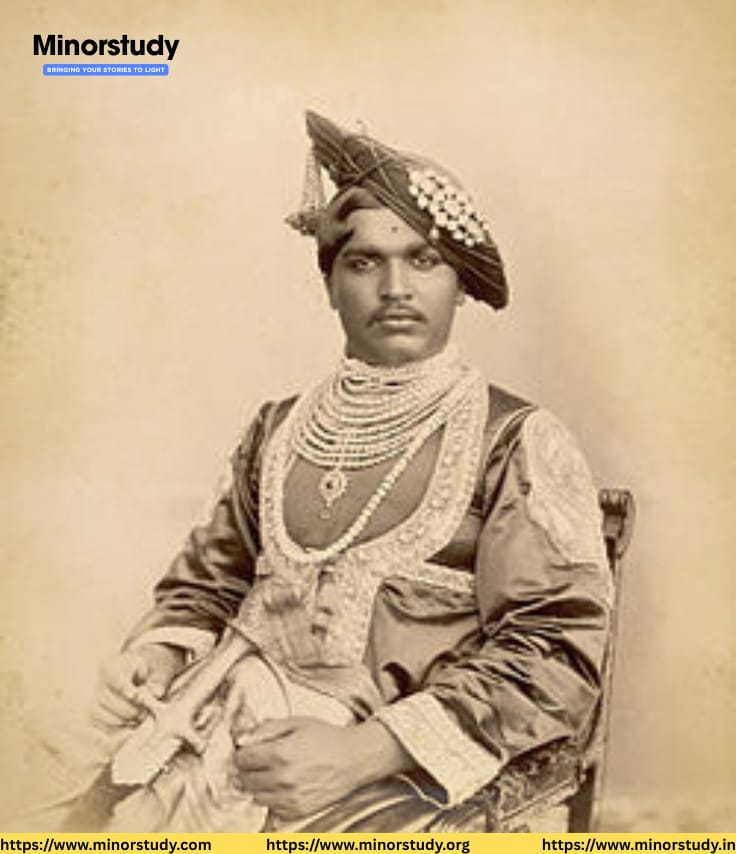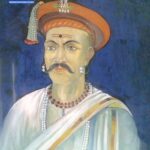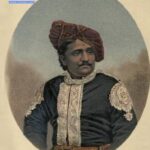🌟 Introduction: Who Was Chhatrapati Shahu Maharaj?
Chhatrapati Shahu Maharaj: When we talk about the Maratha Empire, names like Shivaji Maharaj and Bajirao Peshwa dominate our thoughts. However, Chhatrapati Shahu Maharaj, the grandson of Shivaji Maharaj, played a crucial role in reviving and stabilizing the Maratha kingdom after years of internal and external turmoil.
- 🌟 Introduction: Who Was Chhatrapati Shahu Maharaj?
- 📜 Timeline of Key Events in Shahu Maharaj’s Life
- 📚 A Brief History: The Journey of Shahu Maharaj
- 💥 7 Undeniable Facts That Prove Shahu Maharaj Was a Visionary Leader
- 1. 🏛️ He Revived the Maratha Empire Post-Mughal Suppression
- 2. 🧠 Delegated Power to Talent, Not Just Bloodlines
- 3. ⚖️ He Was a Champion of Justice and Inclusiveness
- 4. 🗡️ Empowered Maratha Expansion Without Wielding the Sword Himself
- 5. 📜 Institutionalized the Hereditary Peshwa System
- 6. 🤝 Maintained Relations with the Mughals Strategically
- 7. 🧭 Balanced Power Between Royalty and Governance
- 🧩 Important Facts About Chhatrapati Shahu Maharaj
- ❓ Frequently Asked Questions (FAQs)
- Q1: Was Shahu Maharaj related to Shivaji?
- Q2: What was Shahu Maharaj’s greatest achievement?
- Q3: How long was Shahu in Mughal captivity?
- Q4: Where is he buried?
- Q5: Did Shahu fight in wars like Shivaji?
- 🎉 Observance and Celebrations
- 🙏 Heartfelt Wishing and Commemoration
- 🧠 Importance in Our Lives
- 🌍 Impact on Society
- 📌 Important Points to Remember
- 🧭 Daily Life Lessons from Shahu Maharaj
- ❤️ Conclusion: Why Chhatrapati Shahu Maharaj Still Matters Today
Chhatrapati Shahu Maharaj was not only a politically astute monarch but also a forward-thinking ruler who laid the foundation for administrative reform, social justice, and empowerment of leaders like Balaji Vishwanath and Bajirao I.
📜 Timeline of Key Events in Shahu Maharaj’s Life
| Year | Event |
|---|---|
| 1682 | Born as Shivaji II to Sambhaji Maharaj |
| 1689 | Captured by the Mughals at age 7 after Sambhaji’s execution |
| 1707 | Released by the Mughals after Aurangzeb’s death |
| 1708 | Crowned Chhatrapati at Satara, beginning his reign |
| 1713 | Appointed Balaji Vishwanath as Peshwa |
| 1720 | Peshwa position made hereditary after Balaji’s death |
| 1749 | Shahu Maharaj passes away in Satara |
📚 A Brief History: The Journey of Shahu Maharaj
Chhatrapati Shahu Maharaj was born in 1682 to Sambhaji Maharaj, Shivaji’s son. After his father’s execution by Aurangzeb, young Shahu was taken as a prisoner by the Mughals and held in captivity for nearly two decades.
When Aurangzeb died in 1707, the Mughals—hoping to divide and weaken the Marathas—released Shahu. Upon returning, he claimed the Maratha throne, but faced opposition from Tarabai, the widow of Rajaram (his uncle). This led to a civil war, which Shahu won.
From 1708 onward, Shahu ruled with wisdom, tolerance, and a vision to rebuild the Maratha Empire. He empowered capable ministers like Balaji Vishwanath and later Bajirao I, leading to the rise of the Peshwa era.
💥 7 Undeniable Facts That Prove Shahu Maharaj Was a Visionary Leader
1. 🏛️ He Revived the Maratha Empire Post-Mughal Suppression
After Shivaji’s death, the Marathas were fragmented. Shahu Maharaj brought political stability by defeating Tarabai’s faction and reuniting the Maratha state. His peaceful acceptance of rivals afterward showed great maturity and long-term vision.
2. 🧠 Delegated Power to Talent, Not Just Bloodlines
He appointed Balaji Vishwanath, a Brahmin administrator, as Peshwa in 1713. This merit-based leadership model allowed the Marathas to thrive under skilled ministers rather than royal lineage alone.
3. ⚖️ He Was a Champion of Justice and Inclusiveness
Shahu Maharaj supported the lower castes, especially during his reign in Kolhapur. He opened reservations in education and administration for marginalized communities—centuries ahead of modern India.
4. 🗡️ Empowered Maratha Expansion Without Wielding the Sword Himself
Though he wasn’t a battlefield warrior like his grandfather Shivaji, Shahu’s support of Bajirao I’s military campaigns laid the foundation for Maratha dominance across India.
5. 📜 Institutionalized the Hereditary Peshwa System
After Balaji Vishwanath’s death in 1720, Shahu declared his son Bajirao as hereditary Peshwa—a move that stabilized succession and empowered long-term administrative planning.
6. 🤝 Maintained Relations with the Mughals Strategically
Unlike rulers who sought total annihilation, Shahu recognized the value of diplomacy. He maintained a nuanced relationship with Mughal successors, sometimes supporting puppet emperors to secure Maratha interests.
7. 🧭 Balanced Power Between Royalty and Governance
He allowed the Peshwas to grow in power but retained symbolic supremacy. This balance prevented excessive centralization and promoted regional governance.
🧩 Important Facts About Chhatrapati Shahu Maharaj
Full Name: Shahuji Bhonsle I
Reign: 1708–1749
Capital: Satara
Known For: Diplomacy, social reform, rise of Peshwa administration
Father: Sambhaji Maharaj
Grandfather: Shivaji Maharaj
Successor: Rajaram II (adopted)
Social Role: Early proponent of caste equality and education
❓ Frequently Asked Questions (FAQs)
Q1: Was Shahu Maharaj related to Shivaji?
Yes, Shahu Maharaj was the grandson of Chhatrapati Shivaji Maharaj through his son Sambhaji Maharaj.
Q2: What was Shahu Maharaj’s greatest achievement?
Uniting the fragmented Maratha factions after his return from Mughal captivity and empowering capable leaders like Balaji Vishwanath and Bajirao I.
Q3: How long was Shahu in Mughal captivity?
He was held for 18 years, from 1689 to 1707, before being released after Aurangzeb’s death.
Q4: Where is he buried?
He is buried in Satara, Maharashtra, where his samadhi (memorial) stands as a mark of respect.
Q5: Did Shahu fight in wars like Shivaji?
Not extensively. He focused more on internal administration, diplomacy, and governance, delegating military campaigns to the Peshwas.
🎉 Observance and Celebrations
Although not widely observed as a national holiday, regional ceremonies and Maratha pride festivals often pay tribute to Shahu Maharaj’s contributions. In Kolhapur and Satara:
Schools and scholars commemorate his social reforms.
Statues and samadhis are visited by citizens.
Speeches and exhibitions educate youth about his legacy.
🙏 Heartfelt Wishing and Commemoration
🌸 “Remembering Chhatrapati Shahu Maharaj—the king who ruled not only with power but with profound compassion.”
🌸 “Let us honor the legacy of a ruler who believed in equality, education, and empowerment—a true pioneer of justice.”
🌸 “May the spirit of Shahu Maharaj inspire today’s leaders to lead with heart and intellect.”
🧠 Importance in Our Lives
In a world where power often overshadows purpose, Chhatrapati Shahu Maharaj’s life is a reminder that leadership can be both strong and sensitive.
He lifted the downtrodden.
He delegated wisely.
He united a broken nation through diplomacy.
His legacy resonates in modern values: equal opportunity, meritocracy, strategic governance, and inclusive policies.
🌍 Impact on Society
Shahu Maharaj’s reign:
Established the Maratha Confederacy, which dominated 18th-century India.
Inspired progressive governance centuries ahead of his time.
Encouraged multi-caste participation in administration and military.
Demonstrated how cultural integration and decentralization can strengthen an empire.
📌 Important Points to Remember
Grandson of Shivaji, son of Sambhaji
18 years in Mughal captivity
Crowned in 1708 at Satara
Empowered Peshwas—Balaji & Bajirao
Social reformer and education promoter
Died in 1749; memorial at Satara
🧭 Daily Life Lessons from Shahu Maharaj
In your own life, you might not be a king, but you can lead like Shahu Maharaj:
Empower those around you instead of hoarding power.
Make decisions based on merit, not emotion or blood.
Adapt with intelligence and compassion, not brute force.
Whether you’re running a home, a team, or a company—remember that true leadership is selfless, strategic, and inclusive.
❤️ Conclusion: Why Chhatrapati Shahu Maharaj Still Matters Today
Chhatrapati Shahu Maharaj is one of India’s unsung heroes—a man whose vision restructured an empire, whose heart lifted the oppressed, and whose decisions shaped the destiny of the Marathas.
He didn’t build walls—he built bridges.
He didn’t conquer with fear—he ruled with fairness.
He didn’t seek glory—he sought justice and unity.
In remembering Shahu Maharaj, we remember the best of Indian leadership—compassionate, courageous, and calculated.








